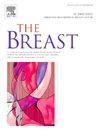Clinical treatment score Post-5 Years (CTS5) predicts the benefit of postmastectomy radiotherapy in patients with T1-2N1 luminal breast cancer
IF 5.7
2区 医学
Q1 OBSTETRICS & GYNECOLOGY
引用次数: 0
Abstract
Purpose
To investigate the clinical value of Clinical Treatment Score Post-5 Years (CTS5) to predict the survival benefits of postmastectomy radiotherapy (PMRT) of patients with T1-2N1 luminal breast cancer (BC).
Methods
Patients who were diagnosed with T1-2N1 luminal BC between 2010 and 2015 were included in the Surveillance, Epidemiology, and End Results database. The chi-square test, binomial logistic regression, Kaplan-Meier analysis, and multivariable Cox proportional hazard model were used for statistical analyses.
Results
A total of 11190 patients were included with a median follow-up time of 76 months. Regarding the CTS5 classification, 1641 (14.7 %), 3915 (35.0 %), and 5633 (50.3 %) patients had low-risk, intermediate-risk, and high-risk diseases, respectively. Patients with younger age, T2 stage, higher tumor grade, a higher number of positive lymph nodes, infiltrating lobular carcinoma subtype, and receipt of chemotherapy were associated with the receipt of PMRT (all P < 0.05). The multivariate analysis showed that the receipt of PMRT was the independent prognostic factor associated with better BCSS (P = 0.005) and OS (P < 0.001). The sensitivity analysis showed that PMRT did not improve BCSS (low-risk, P = 0.932; intermediate-risk, P = 0.952) and OS (low-risk, P = 0.637; intermediate-risk, P = 0.825) compared to those without PMRT in the low-risk and intermediate-risk groups. However, PMRT improved BCSS (P = 0.003) and OS (P < 0.001) in those with high-risk groups compared to those without PMRT.
Conclusions
CTS5 is an innovative model that could predict the survival benefit of PMRT for T1-2N1 luminal BC patients.
临床治疗5年后评分(CTS5)预测T1-2N1腔型乳腺癌患者乳房切除术后放疗的获益。
目的:探讨5年后临床治疗评分(CTS5)在预测T1-2N1腔型乳腺癌(BC)患者乳房切除术后放疗(PMRT)生存获益中的临床价值。方法:将2010 - 2015年间诊断为T1-2N1腔内BC的患者纳入监测、流行病学和最终结果数据库。采用卡方检验、二项logistic回归、Kaplan-Meier分析和多变量Cox比例风险模型进行统计分析。结果:共纳入11190例患者,中位随访时间76个月。在CTS5分类中,低危、中危、高危患者分别为1641例(14.7%)、3915例(35.0%)、5633例(50.3%)。年龄小、T2分期、肿瘤分级高、淋巴结阳性数量多、浸润性小叶癌亚型多、接受化疗的患者接受PMRT相关(均P)结论:CTS5是一种创新模型,可预测T1-2N1腔内BC患者PMRT的生存获益。
本文章由计算机程序翻译,如有差异,请以英文原文为准。
求助全文
约1分钟内获得全文
求助全文
来源期刊

Breast
医学-妇产科学
CiteScore
8.70
自引率
2.60%
发文量
165
审稿时长
59 days
期刊介绍:
The Breast is an international, multidisciplinary journal for researchers and clinicians, which focuses on translational and clinical research for the advancement of breast cancer prevention, diagnosis and treatment of all stages.
 求助内容:
求助内容: 应助结果提醒方式:
应助结果提醒方式:


